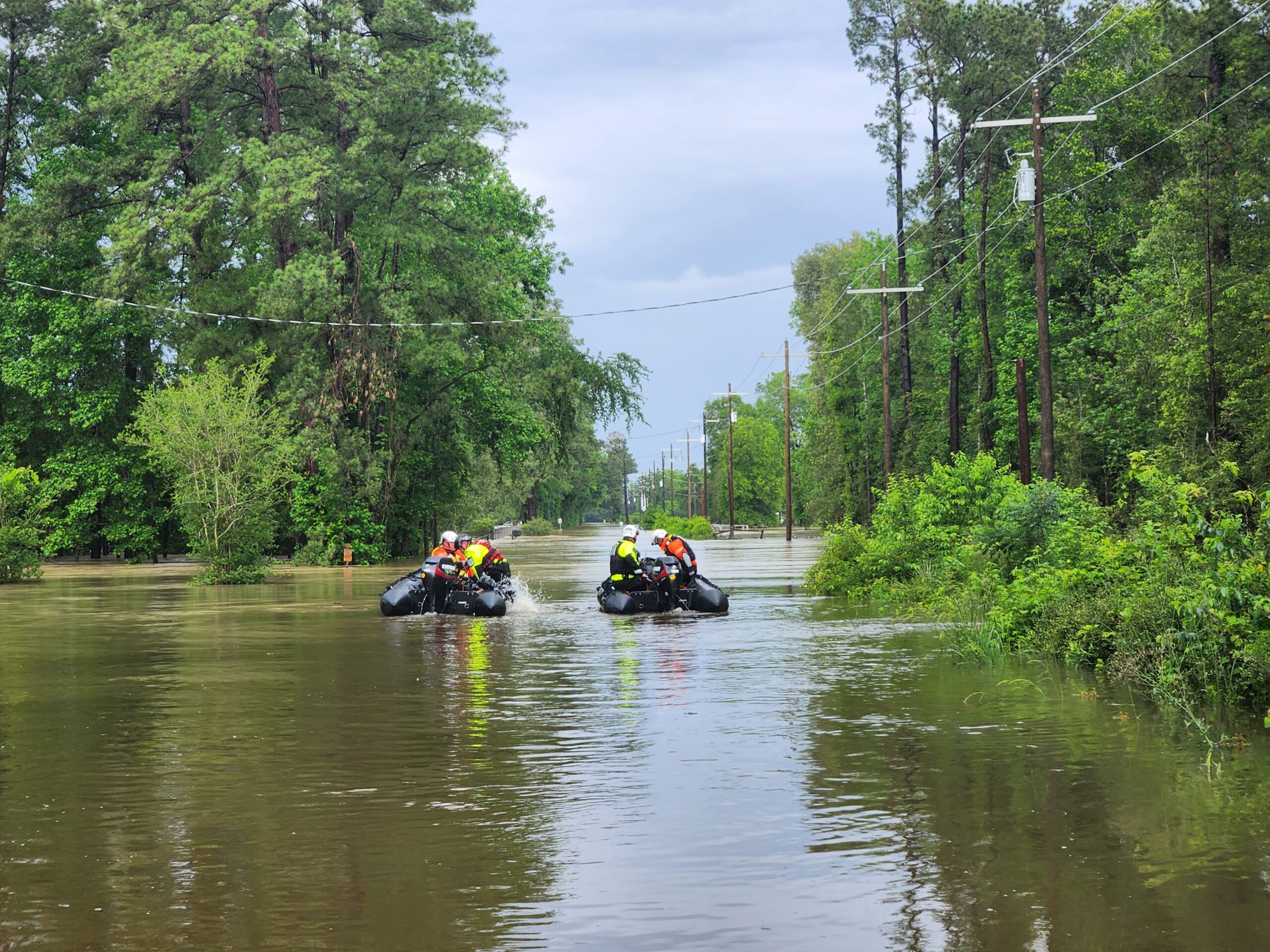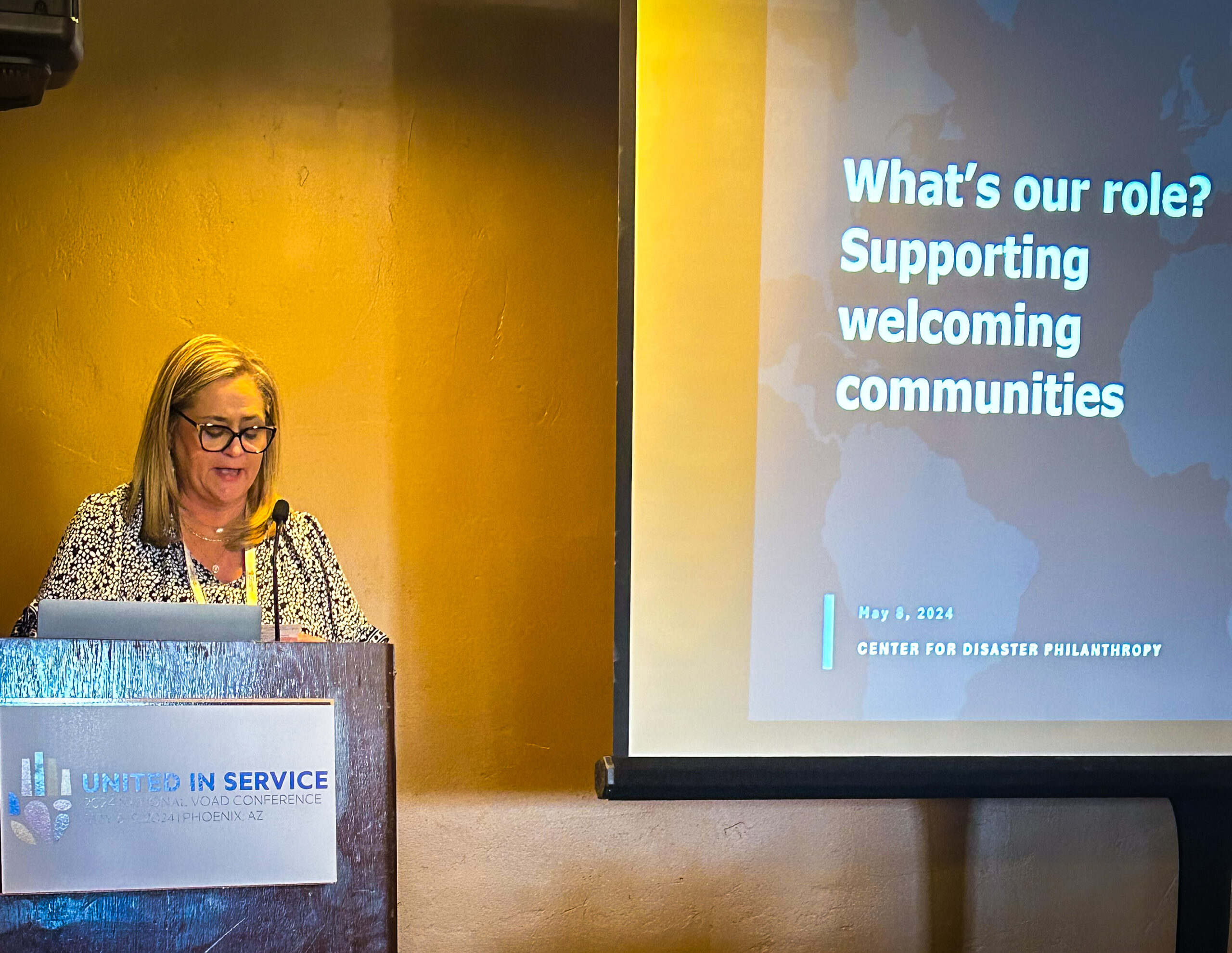What we’re watching: Weekly disaster update, June 24

Editor’s note: The “What we’re watching” blog posts are currently on a summer schedule. A new post will be published on a biweekly basis. The next blog will be published on July 8.
We know all too well that disaster can strike anytime, anywhere in the world. Some disasters make headlines; others do not. Here at the Center for Disaster Philanthropy (CDP), we monitor the status of disasters worldwide and compile a list of the ones we’re tracking weekly, along with relevant disaster-related media coverage.
Here’s what we’re watching for the week of June 24, 2024.
New or Emerging Disasters
Multiple hazards – New Mexico/Arizona/Nevada: New Mexico is facing a convergence of five disasters simultaneously; and monsoon season is just around the corner.
Already in a state of drought, two devastating wildfires began burning in New Mexico on June 18. Hail and heavy rain from Tropical Storm Alberto on June 20 hampered firefighters’ ability to access the fires and flooding in new and old wildfire scar areas led to debris flows. To add to the misery, a haboob – a major dust storm – stretched hundreds of miles across New Mexico and Arizona – on June 20.
The larger of the two wildfires, named the South Fork Fire, ignited in the Mescalero Apache tribal region and rapidly spread beyond tribal land to the tourist community of Ruidoso. As of June 24, it has reached 17,551 acres and had 37% containment.
A second fire, the Salt Fire, has consumed nearly 8,000 acres of tribal land with only 7% containment. The fires have destroyed over 1,400 structures (including close to 1,000 homes) and forced the evacuation of thousands of residents in Lincoln County. Two people were killed and an unknown number may be missing. Full containment isn’t expected until July 15.
Many of Lincoln County and Ruidoso’s year-round residents were allowed home over the weekend and Monday, June 23, although officials warned there would be limited access to groceries, and water, electricity and gas services may be turned off. Tourists and those with second homes in the area were asked to stay away.
On June 20, extreme rain hit New Mexico and Las Vegas complicated the work to contain the fires. The storms increased humidity and dampened the fires, but created new dangers to manage as some emergency crews had to be evacuated due to flooding, mudslides and blocked roads in several areas. Additionally, the heavy rain in burn scars of previous fires created debris slides as fallen and charred trees were picked up by rushing water.
President Joe Biden declared a major disaster declaration for the area including Individual and Public Assistance (DR-4795).
For more information about current wildfires, see our 2024 North American Wildfires disaster profile.
Flooding – Iowa/Minnesota/South Dakota: Located in Northwestern Iowa, the small city of Rock Valley, Sioux County, faced an early morning evacuation after a levee break on the Rock River on June 22. It was just one of several communities in the area that are now underwater after heavy rains caused multiple rivers in South Dakota and Iowa to exceed flood stage and overtop banks. At least 1,900 properties were damaged or destroyed, including 500 homes in Rock Valley, and 16 flood gauges set records, many breaking those set in 1993.
Areas south of the currently affected area are also at risk of flash flooding as the water moves downstream in the next several days.
Rock Valley officials set off the city’s tornado siren at 2 a.m. Saturday morning to alert residents to the danger after four inches of rain fell in 90 minutes. The town of Spencer was flooded by the Little Sioux River on Saturday morning after the river level reached what the mayor called “epic proportions,” surpassing the record set in 1953.
Ten water systems and 21 wastewater systems were flooded or lost power across the state. Iowa Gov. Kim Reynolds issued a state disaster proclamation and asked for federal assistance.
Likewise, in South Dakota, Gov. Kristi Noem also declared an emergency after heavy rain caused flooding, shutting down several highways in the southeastern part of the state. The state’s largest city, Sioux Falls received seven inches of rain in three days. Canton, about 30 miles from Sioux Falls received 18 inches of rain.
For more information about this year’s severe weather events, see our 2024 US Severe Weather disaster profile.
Also, join us this Thursday for our U.S. severe weather: How funders can support recovery webinar.
Join us this Thursday, June 27
Webinar: U.S. severe weather: How funders can support recovery

Heat – Mexico: Much of Mexico is facing extreme heat. At least 125 people have died so far this year and more than 2,300 have suffered complications, such as dehydration or heat stroke. The Gulf coast state of Veracruz has seen one-third of the country’s deaths.
Extreme heat deaths are often measured through excess mortality studies which compare the typical number of deaths with deaths during high-temperature days. AP said, “The heat deaths and larger ripple effects in Mexico have underscored the disproportionate effects climate change and rising global temperatures are having on some of the world’s most vulnerable.” Mid-June saw the hottest day in Mexican history to the Sonoran Desert – an incredible 125 degrees.
Heat – Middle East and Central Asia: The annual Hajj pilgrimage to Mecca turned deadly for hundreds this year who made the trek to the Saudi Arabian desert. Egyptian officials have reported 323 of its citizens have died, along with at least 35 from Tunisia, 138 from Indonesia and more than 40 from Jordan.
Temperatures during the event hit 125˚F. The Washington Post stated, “The outcome — in this instance — shows how mass-scale outdoor gatherings have the potential to become more lethal as parts of the world warm beyond what humans can withstand.”
Temperatures across the Middle East and Central Asia continually set records throughout June, affecting several countries, including Oman, Iraq, Algeria and Iran.
Tropical Storm Alberto – Mexico and Texas: At least four people were killed after Tropical Storm Alberto, the first named storm of the Atlantic hurricane season, made landfall in Tampico, in northeast Mexico on June 20. The storm weakened into a tropical depression later that day.
All four deaths were in the state of Nuevo Léon. Heavy rain hit Mexico and southern Texas on June 19, causing flash flooding. Monterrey, Nuevo Léon’s capital and home to many of Mexico’s biggest companies, flooded.
Texas Governor Greg Abbott issued a disaster declaration for 51 counties on June 19. Many counties along the coast flooded as heavy rains drenched the area, bringing more than four feet of storm surge to some communities.
For more, see our 2024 Atlantic Hurricane Season disaster profile.
Wildfires – Brazil: As Brazil continues to deal with the impact of floods in Rio Grande del Sol, the Pantanal region, the world’s largest tropical wetlands, is experiencing earlier and bigger fires. There has been a 1,000% increase in wildfires this year, compared to this time 2023. The Pantanal didn’t experience the same level of rain and flooding this year that it has in previous years.
Floods – Bangladesh and India: More than 2.1 million people were affected after monsoon rains in northeastern Bangladesh and neighboring Indian states of Meghalaya and Assam on June 17-18. Much of the flooding comes from saturated land that cannot absorb the excessive snow runoff from the hilly areas bordering India. This is the second wave of severe flooding in a month in Bangladesh.
Nearly 2,000 shelters housed more than 51,000 people after the floods. Almost 8,000 people were affected in 33 camps in Cox’s Bazar. Nearly 10 inches of rain fell in Sylhet and Sunamganj districts. Nearly 75% of Sylhet is flooded and there is likely to be significant impacts on food security as more than half of crops and paddy fields have been flooded.
As of June 19, 15 people died in floods and landslides, including at least seven Rohingya refugees.
Severe Weather – China: Multiple calamities have affected different parts of China including extreme heat, heavy rains, floods and landslides. Southern China saw extensive flooding around June 17, while northern China faced days of 105˚F+ heat. Economic damage from the flooding is approaching $300 million. Residents were without power, landslides caused deaths and at least 300 homes collapsed.
Low rainfall in northern China is also raising concerns of drought as water levels decrease. The heat wave and drought are expected to continue.
Previous/Ongoing Disasters
Tornadoes – U.S.: During May, there were 570 tornado reports, which NOAA says was double the 20-year average of 268.4 tornadoes and exceeded May 2003’s record 550 twisters.
On June 22, at least six tornadoes touched down in Wisconsin, ranging from EF-0 to EF-2. This brings the total number of twisters in June in the state to 33, 10 higher than the average year-to-date
For more, see our 2024 US Tornadoes disaster profile.
ENSO – Global: According to the National Weather Service (NWS), El Niño is officially over, but we’re not yet at La Niña. If La Niña does develop (predicted to begin in July-September and potentially persist through early 2025), it will likely move more hurricanes into the Atlantic basin, instead of the Gulf of Mexico. La Niña summers that come on the heels of El Niño winters, also tend to be extremely hot, and extreme heat events like those we’ve seen over the past couple of weeks may extend for months.
Heat Wave – India: India’s Health Ministry released data on June 20, showing that at least 110 people died between March 1 and June 18 due to extreme heat. The highest number – 36 – was reported in Uttar Pradesh state. There were more than 40,000 cases of suspected heat stroke in the same period. Almost 500 suspected heat stroke cases were reported on June 18 alone.
The annual monsoon rains are expected shortly and the unusually long heat wave is expected to be over by the end of June.
Heat Wave – U.S.: According to the National Center for Environmental Information, more than 1,200 daytime and almost 1,800 nighttime high-temperature records were broken or tied in the United States between June 1 to June 15.
Over the June 22-23 weekend, 15 million people across the U.S. were under a “heat warning,” the highest level of heat alerts. Another 90 million spent the weekend under a heat advisory. Researchers now know that heat’s danger point is much lower than previously believed. AP analysis found that excessive heat contributed to more than 2,300 deaths in 2023, the highest in 45 years.
One impact of extreme heat is the failure of the electrical grid, as was seen in Puerto Rico on June 13, when nearly 350,000 customers lost power. The island is still rebuilding its grid after the destruction caused by Hurricane Maria in 2017.
In addition to the disasters listed above, we actively monitor the following disasters or humanitarian emergencies. For more information, see the relevant disaster profiles, which are updated regularly.
- Afghanistan Humanitarian Crisis
- 2024 East Africa Flooding and Cyclones
- Gaza-Israeli Humanitarian Crisis
- Haiti Humanitarian Crisis
- Horn of Africa Hunger Crisis
- 2024 Rio Grande do Sul Brazil Floods
- Sudan Humanitarian Crisis
Complex Humanitarian Emergencies – Central African Republic (CAR)
Many places worldwide are experiencing emergencies caused by conflict, climate change, drought, famine, economic challenges and other conditions that combine to create a complex humanitarian emergency (CHE). CDP maintains complete profiles on several CHEs, and what CDP considers Level 1 CHEs are profiled in this weekly blog post and tracked.
In 2024, humanitarians in CAR aim to assist 2.8 million of the most vulnerable people in the country. The crisis in neighboring Sudan has had spillover effects and that combined with increased activities of armed groups within CAR has complicated the security landscape and worsened the humanitarian situation.
In Sudan, fighting between the Sudanese Armed Forces and the Rapid Support Forces have continued since the beginning of the conflict in April 2023, resulting in the displacement of millions of people. Since April 2023, 31,649 forcibly displaced people from Sudan have arrived in CAR, including 25,491 Sudanese refugees and 6,158 Central African returnees.
The security of refugees in the Bamingui-Bangoran Prefecture in particular remains a major challenge due to the presence and activities of armed groups there. During the week of June 13-19, the number of protection incidents reported increased due to an upsurge in robberies and hold-ups in some areas of northern CAR.
There are serious protection concerns in CAR with gender-based violence on the rise amid ongoing conflict, weak legal and care systems and the stigma of speaking up. Since 2020, incidents have increased from about 9,200 reported cases to 25,500. International funding for CAR has decreased, with gender-based violence receiving some of the least support.
What We’re Reading
- LGBTQIA+ Communities and Disasters – CDP Issue Insight: Happy Pride Month! Disasters disproportionately affect LGBTQIA+ communities. CDP has an Issue Insight focused on LGBTQIA+ populations. You can also access these resources from ASPR TRACIE which CDP helped update last year.
- FEMA is ready for an extreme hurricane and wildfire season, but money is a concern, Mayorkas says – Associated Press: “Mayorkas said one reason FEMA is prepared is that the agency staff has gotten so much practice responding to disasters as climate change has intensified.”
- 2024 Global Report on Internal Displacement – Norwegian Refugee Council and Internal Displacement Monitoring Centre: The report found that 75.9 million people were internally displaced as of Dec. 31 2023, up from 71.1 million at the same time in 2022. Of these 68.3 million were displaced because of conflict and 7.7 million because of disasters.
- Asia was most impacted by extreme weather and climate in 2023, UN report shows – CNBC: A report “The State of Climate in Asia 2023” by the World Meteorological Organization found Asia was the most disaster-hit region in the world last year. The report stated that many countries had their hottest weather ever, nine million people were affected by storms and floods and more than 2,000 people died.
- El Niño and climate change impacts slam Latin America and Caribbean in 2023 – World Meteorological Organization: “A double-whammy of El Niño and long-term climate change hit Latin America and the Caribbean in 2023, according to a new report from the World Meteorological Organization (WMO). Drought, heat, wildfires, extreme rainfall and a record-breaking hurricane had major impacts on health, food and energy security and economic development.”
- As climate change amplifies urban flooding, here’s how communities can become ‘sponge cities’ – The Conversation: The term ‘sponge cities’ originated in China in 2010, but the concept is much older. Essentially, areas of a community are developed in ways that allow them to act like a sponge by absorbing water and preventing it from going into the sewer system. More intense than green infrastructure (green roofs, rain gardens), sponge cities build streets in ways that direct water into parks and recreational fields so that they can flood instead of streets (and homes and businesses).
Since we’re currently publishing this post every two weeks, you get two inspiring stories to carry you through.
- In a beautiful photo essay, photojournalists followed families for two years to tell the story of some of the 230,000 people who have helped keep trains running in Ukraine. For more inspiring content from Ukraine, check out some of our grantee partner impact stories.
- Now that’s ingenuity!! An Oregon winery transformed smoke-damaged wine from September 2020’s wildfires into an artisan barbeque sauce. From the barrel to the grill, or from smoky wine to smoky food.
Did you miss recent CDP blog posts?

What’s our role in supporting welcoming communities? Reflections from a National VOAD Conference discussion

